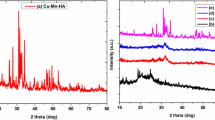Abstract
The nanocomposite particles of hydroxyapatite–tussah silk fibroin (HA–TSF) and HA–chitosan (HA–CS) were developed by biomimetic synthesis using Ca(NO3)2 and Na3PO4 as the precursors of inorganic phase in the presence of TSF and CS. Both nanocomposite particles were carbonate-substituted HA with low crystallinity. TSF and CS induced preferential alignment of HA crystallites along the direction of c-axis, and the induction effect of TSF was more than of CS. HA–TSF and HA–CS nanocomposite particles were found to be needle-like in the shape with a typical size of 100–200 nm in length and about 20 nm in width, and 115–250 nm in length and about 25 nm in width, respectively, as the result of the preferential arrangement of HA crystallites along c-axis intensified by TSF and CS. Based on both nanocomposite particles, the bone-like nanocomposites of HA–TSF/CS and HA–CS/TSF with the same compositions were prepared by isostatic pressing using CS and TSF concentrated solutions as adhesive composition, respectively. However, the two bone-like nanocomposites exhibited significantly different mechanical properties. The compressive strength, compressive modulus, and bending strength of HA–TSF/CS composite were significantly higher than of HA–CS/TSF composite. The fracture mechanism of both composites was analyzed by SEM observation. The study result indicates that HA–TSF/CS nanocomposite is an ideal candidate for bone substitute materials.







Similar content being viewed by others
References
Kikuchi M, Itoh S, Ichinose S, Shinomiya K, Tanaka J (2001) Self-organization mechanism in a bone-like hydroxyapatite/collagen nanocomposite synthesized in vitro and its biological reaction in vivo. Biomaterials 22:1705–1711
Du C, Cui FZ, Zhang W, Feng QL, Zhu XD, Groot KD (2000) Formation of calcium phosphate/collagen composites through mineralization of collagen matrix. J Biomed Mater Res 50:518–527
Rho JY, Kuhn-Spearing L, Zioupos P (1998) Mechanical properties and the hierarchical structure of bone. Med Eng Phys 20:92–102
Fratzl P, Weinkamer R (2007) Nature’s hierarchical materials. Prog Mater Sci 52:1263–1334
Chang MC, Ikoma T, Kikuchi M, Tanaka J (2001) Preparation of a porous hydroxyapatite/collagen nanocomposite using glutaraldehyde as a crosslinkage agent. J Mater Sci Lett 20:1199–1201
Yin YJ, Zhao F, Song XF, Yao KD, Lu WW, Leong JC (2000) Preparation and characterization of hydroxyapatite/chitosan–gelatin network composite. J Appl Polym Sci 77:2929–2938
Bigi A, Boanini E, Panzavolta S, Roveri N, Rubin K (2002) Bonelike apatite growth on hydroxyapatite–gelatin sponges from simulated body fluid. J Biomed Mater Res 59:709–714
Ma PX, Zhang RY, Xiao GZ (2007) Enginering new bone tissue in vitro on highly porous poly(a-hydroxyl acids)/hydroxyapatite composite scaffolds. J Biomed Mater Res 54:284–293
Yamaguchi I, Tokuchi K, Fukuzaki H (2007) Preparation and microstructure analysis of chitosan/hydroxyapatite nanocomposites. J Biomed Mater Res 55:20–27
Wang L, Nemoto R, Senna M (2004) Changes in microstructure and physico-chemical properties of hydroxyapatite–silk fibroin nanocomposite with varying silk fibroin content. J Eur Ceram Soc 24:2707–2715
Nemoto R, Wang L, Ikoma T, Tanaka J, Senna M (2004) Preferential alignment of hydroxyapatite crystallites in nanocomposites with chemically disintegrated silk fibroin. J Nanopart Res 6:259–265
Rhee SH, Tanaka J (2002) Self-assembly phenomenon of hydroxyapatite nanocrystals on chondroitin sulfate. J Mater Sci Mater Med 13:597–600
Rhee SH, Tanaka J (2000) Effect of chondroitin sulfate on the crystal growth of hydroxyapatite. J Am Ceram Soc 83:2100–2102
Sun XD, Zhou YL, Ren JY, Cui FZ, Li HD (2007) Effect of pH on the fibroin regulated mineralization of calcium phosphate. Curr Appl Phys 7:75–79
He JX, Wang Y, Cui SZ, Gao YY, Wang SY (2010) Structure and miscibility of tussah silk fibroin/carboxymethyl chitosan blend films. Iran Polym J19:625–633
Minoura N, Aiba SI, Higuchi M (1995) Attachment and growth of fibroblast cells on silk fibroin. Biochem Biophys Res Commun 8:511–516
Pierschbacher MD, Ruoslahti E (1984) Cell attachment activity of fibronectin can be duplicated by small synthetic fragments of the molecule. Nature 309:30–33
Cai Y, Jin J, Mei D, Xia N, Yao J (2009) Effect of silk sericin on assembly of hydroxyapatite nanocrystals into enamel prism-like structure. J Mater Chem 19:5751–5758
Chang MC, Tanaka J (2002) FT-IR study for hydroxyapatite/collagen nanocomposite cross-linked by glutaraldehyde. Biomaterials 23:4811–4818
Fredd G, Monti P, Nagura M, Gotoh Y, Tsukada M (1997) Structure and molecular conformation of tussah silk fibroin films: effect of heat treatment. J Polym Sci B 35:841–847
Nakazawa Y, Asakura T (2002) High-resolution 13C CP/MAS NMR study on structure and structural transition of Antheraea pernyi silk fibroin containing poly(l-alanine) and gly-rich regions. Macromolecules 35:2393–2400
Acknowledgments
This research was financially supported by the Programme of Introducing Talents of Discipline to Universities, B07024, China, and we also acknowledged the support from China Postdoctoral Science Foundation funded project (20080430079, 200902194).
Author information
Authors and Affiliations
Corresponding author
Rights and permissions
About this article
Cite this article
He, J., Wang, D. & Cui, S. Novel hydroxyapatite/tussah silk fibroin/chitosan bone-like nanocomposites. Polym. Bull. 68, 1765–1776 (2012). https://doi.org/10.1007/s00289-012-0702-5
Received:
Revised:
Accepted:
Published:
Issue Date:
DOI: https://doi.org/10.1007/s00289-012-0702-5




